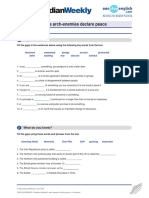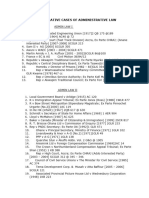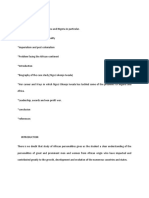Stories To and Fro: Highway 39: Journeys Through A Fractured Land by Sudeep
Stories To and Fro: Highway 39: Journeys Through A Fractured Land by Sudeep
Uploaded by
ARKA DATTACopyright:
Available Formats
Stories To and Fro: Highway 39: Journeys Through A Fractured Land by Sudeep
Stories To and Fro: Highway 39: Journeys Through A Fractured Land by Sudeep
Uploaded by
ARKA DATTAOriginal Description:
Original Title
Copyright
Available Formats
Share this document
Did you find this document useful?
Is this content inappropriate?
Copyright:
Available Formats
Stories To and Fro: Highway 39: Journeys Through A Fractured Land by Sudeep
Stories To and Fro: Highway 39: Journeys Through A Fractured Land by Sudeep
Uploaded by
ARKA DATTACopyright:
Available Formats
STORIES TO AND FRO
Highway 39: Journeys through a fractured land By Sudeep Chakravarti, Fourth Estate, Rs 450
Sudeep Chakravartis book is an earnest attempt to focus Indias attention on the strifetorn Northeast. Chakravarti rests his hope in the power of stories tales that he gathers during his journey from Numaligarh in Assam to Moreh near the border with Myanmar in Manipur to force an apathetic democracy change its ways of dealing with dissidence. The stories, gathered from militants, military officers, bureaucrats and activists, echo the chronicles from Kashmir and Chhattisgarh, the two other dots that can be joined to draw a map of Indias fractured lands. A 14-year-old Naga girl shot dead by an army man for resisting rape; an 11-year-old Manipuri girl left traumatized after her abduction by the police; a staged encounter spilling the blood of a woman and her unborn child. Such retellings are crucial to bolster civil movements the Apunba Lup in Manipur, for instance that are fighting to bring justice to Indias forgotten corners. But this book is not merely an examination of the brutal political and military repression of a people demanding self-determination. It addresses some key, and troubling, questions concerning Indian democracy, the idea of nationhood and the factors that have helped sustain the conflict. Indias claim as an upholder of democratic principles is brought under severe strain by the fact that geopolitical compulsions have forced successive prime ministers to violently put down a strident demand for sovereignty by an indigenous people. But the roots of the demand for self-determination in Nagaland stem from cultural and ethnic differences. This problematizes the idea of the nation itself as such a concept may not necessarily be acceptable to communities that derive their identity from a loosely built and intricate network of ethnic affiliations. Chakravartis preferred solution is the Naga people working in tandem with the Indian State to bring about the merger of Naga territories within or outside the ambit of Indias Constitution. But can such an arrangement survive the tensions arising out of the fluid and complicated nature of tribal affiliations? The longevity of the violence, Chakravarti argues, can be attributed to the fact that every conflict brings in its wake its own economics, creating a class of people which benefits
from it. In 2008, Nagaland received Rs 23 billion in the form of Central aid but a report by the Comptroller and Auditor General of India unearthed several cases of financial irregularity. Not just bureaucrats and politicians but the rebel groups too profit from the economics of conflict. For instance, protection money is demanded by dominant factions. Chakravarti also recounts an incident in the village of Yikhum in which NSCNIM officials colluded with a corrupt bureaucracy and arrested villagers protesting against the theft of public funds. The pervasive corruption has contributed to the erosion of the peoples faith in elected representatives as well as rebels. The factionalism, encouraged and allegedly engineered by the Indian government, that has plagued the insurrection raises credible questions about the wisdom of waging an armed campaign against the State. But then again, peoples movements that remain sympathetic to the Naga underground but nonetheless prefer democratic means of protest have also suffered because of the lack of leadership. Yet peace and change in the Northeast remain dependent on dialogue that creates the scope for the trickling in of terrible truths to the mainland. Highway 39, metaphorically, is one such conduit for the traffic of tales that India must not be allowed to forget. UDDALAK MUKHERJEE
You might also like
- Writing Gender Writing Nation Women S Fiction in Post-Independence IndiaDocument4 pagesWriting Gender Writing Nation Women S Fiction in Post-Independence IndiaANKIT KUMAR DUBEYNo ratings yet
- Conversation in The CathedralDocument2 pagesConversation in The CathedralARKA DATTA0% (1)
- Quiz On Economic GlobalizationDocument2 pagesQuiz On Economic GlobalizationKc SevillaNo ratings yet
- The Lure of Authoritarianism: The Maghreb after the Arab SpringFrom EverandThe Lure of Authoritarianism: The Maghreb after the Arab SpringNo ratings yet
- Appointment - Arming of Civilians As Special Police Officer - Spo in Anti-Naxal Operation - UnconstitutionalDocument81 pagesAppointment - Arming of Civilians As Special Police Officer - Spo in Anti-Naxal Operation - UnconstitutionalSridhara babu. N - ಶ್ರೀಧರ ಬಾಬು. ಎನ್No ratings yet
- Will India Become A Superpower?: Ramachandra GuhaDocument11 pagesWill India Become A Superpower?: Ramachandra Guhababban05No ratings yet
- Maoists As Political Prisoners?Document4 pagesMaoists As Political Prisoners?M C RajNo ratings yet
- Iraq Playing A Cynical Game of DemocracyDocument2 pagesIraq Playing A Cynical Game of Democracyawat444No ratings yet
- About Us: Archive: Contact Us: Editorial Board: Submission: FaqDocument8 pagesAbout Us: Archive: Contact Us: Editorial Board: Submission: Faq123prayerNo ratings yet
- Manipur Conflict 3Document6 pagesManipur Conflict 3swagwahwaNo ratings yet
- Civil Services Mentor August 2013Document139 pagesCivil Services Mentor August 2013Peter BeckNo ratings yet
- Kashmir and Nation StateDocument29 pagesKashmir and Nation Statemr.anupambanerjee6651No ratings yet
- Naxalism A Basic OverviewDocument3 pagesNaxalism A Basic Overviewaharish_iitkNo ratings yet
- DemocracyDocument28 pagesDemocracyRai Mohammad AshfaqNo ratings yet
- Insurgency Counter Insurgency and DemocrDocument20 pagesInsurgency Counter Insurgency and Democrnandini.g.choudharyNo ratings yet
- A Question of Order: India, Turkey, and the Return of StrongmenFrom EverandA Question of Order: India, Turkey, and the Return of StrongmenRating: 3.5 out of 5 stars3.5/5 (3)
- Polity - Vol. 5 - No. 6Document44 pagesPolity - Vol. 5 - No. 6Social Scientists' AssociationNo ratings yet
- Democracy in KashmirDocument12 pagesDemocracy in KashmirMoin AftabNo ratings yet
- Predecessor Used Dawn Leaks' To Get Extension, Claims Gen BajwaDocument44 pagesPredecessor Used Dawn Leaks' To Get Extension, Claims Gen Bajwatooba zaidiNo ratings yet
- Afterword (2006) The Immoral Economy of Counter Insurgency in IndiaDocument37 pagesAfterword (2006) The Immoral Economy of Counter Insurgency in Indiaaggarwal9No ratings yet
- India's Democracy and Its CriticsDocument19 pagesIndia's Democracy and Its Criticsvermashubham26739No ratings yet
- Citizenship in A Democratic SocietyDocument9 pagesCitizenship in A Democratic SocietySuvidutt SundaramNo ratings yet
- A Case For New Social ContractDocument2 pagesA Case For New Social ContractHussain Mohi-ud-Din QadriNo ratings yet
- 1-Solidarity Across Cultures PDFDocument6 pages1-Solidarity Across Cultures PDFachyanuddinNo ratings yet
- Indian Herbary of Federal BlossomDocument8 pagesIndian Herbary of Federal BlossomSuvidutt SundaramNo ratings yet
- Nationalism and Nation-State As Discourse in IndiaDocument3 pagesNationalism and Nation-State As Discourse in IndiaYuvraj ThakoreNo ratings yet
- Ethno Nationalism in Pakistan A Commentary On Muhajir Qaumi Mahaz MQM in SindhDocument25 pagesEthno Nationalism in Pakistan A Commentary On Muhajir Qaumi Mahaz MQM in SindhHira TajammalNo ratings yet
- Dalit Politics in IndiaDocument9 pagesDalit Politics in IndiaDivyanshi RathoreNo ratings yet
- Democracy Is A Noble ConceptDocument6 pagesDemocracy Is A Noble Conceptatifrana4494No ratings yet
- CSS Essay DemocracyDocument24 pagesCSS Essay DemocracyAtta Dhaku40% (5)
- Democracy! Shape of Things To ComeDocument3 pagesDemocracy! Shape of Things To ComeAdeel AbbasNo ratings yet
- mg279 AllDocument32 pagesmg279 AllsyedsrahmanNo ratings yet
- Right To Secession.Document32 pagesRight To Secession.KokNo ratings yet
- Democratic Predicament of Pakistan: by Hammad RazaDocument4 pagesDemocratic Predicament of Pakistan: by Hammad RazaYasir Bhatti BhattiNo ratings yet
- The People's Throne: A Leader's Journey in the World's Largest DemocracyFrom EverandThe People's Throne: A Leader's Journey in the World's Largest DemocracyNo ratings yet
- Roy English 1Document14 pagesRoy English 1Mohamed Shaffeeq NNo ratings yet
- Two Faces of Middle ClassDocument8 pagesTwo Faces of Middle ClassAjit SidhuNo ratings yet
- Improve ExpressionsDocument3 pagesImprove ExpressionsNaveed AhmedNo ratings yet
- Dynastic PoliticsDocument5 pagesDynastic PoliticsMOHAMMAD BABARNo ratings yet
- Nowhere Left To GoDocument4 pagesNowhere Left To GoshaliniNo ratings yet
- Daupdi ExplainedDocument6 pagesDaupdi Explainedankur13choudhary8No ratings yet
- Hitler and The LTTE On Polarisation and FascismDocument15 pagesHitler and The LTTE On Polarisation and FascismThavamNo ratings yet
- Manazar Hussain Qureshi: Why Democracy Faild in PakistanDocument3 pagesManazar Hussain Qureshi: Why Democracy Faild in Pakistanmanazar hussainNo ratings yet
- Wordcraft and Statecraft PDFDocument462 pagesWordcraft and Statecraft PDFBahuvirupakshaNo ratings yet
- Myanmar's Generals Have United The Country-Against Themselves - The EconomistDocument6 pagesMyanmar's Generals Have United The Country-Against Themselves - The Economist100453432No ratings yet
- The Myth of Ethnic Conflict in Manipur Part 1Document5 pagesThe Myth of Ethnic Conflict in Manipur Part 1Ibosana PhilemNo ratings yet
- Democracy and External InfluenceDocument23 pagesDemocracy and External Influencejoseph ogbanjeNo ratings yet
- Indian Express 27 September 2012 10Document1 pageIndian Express 27 September 2012 10Shahabaj DangeNo ratings yet
- Democracy in PakistanDocument3 pagesDemocracy in Pakistanمرزا عظيم بيگ33% (3)
- What Is Democracy Why DemocracyDocument25 pagesWhat Is Democracy Why DemocracyPramod SharmaNo ratings yet
- Democracy and ExtremismDocument4 pagesDemocracy and ExtremismThb OneWorldNo ratings yet
- Whatever Has Happened To Civil SocietyDocument7 pagesWhatever Has Happened To Civil SocietyRatendra Pal SinghNo ratings yet
- Kanbawza Burmese Army Is Anathema To DemocracyDocument5 pagesKanbawza Burmese Army Is Anathema To DemocracyAUNG M.RyomaNo ratings yet
- Ethnic Conflict and The 2010 Elections in BurmaDocument18 pagesEthnic Conflict and The 2010 Elections in BurmaNay HtutNo ratings yet
- University of The Cordilleras SOC SCI 103N The Contemporary World BSCE/1 /CITCS INTL2 MTH10:00AM-12:30pmDocument5 pagesUniversity of The Cordilleras SOC SCI 103N The Contemporary World BSCE/1 /CITCS INTL2 MTH10:00AM-12:30pmChaelvin Freian SingsonNo ratings yet
- Democracy ArticlesDocument53 pagesDemocracy Articleskg243173No ratings yet
- At War With OneselfDocument25 pagesAt War With Oneselfnandinisundar100% (2)
- The Fascist Nature of Indian Communalism - Dilip Simeon's Essay "The Philosophy of Number"Document17 pagesThe Fascist Nature of Indian Communalism - Dilip Simeon's Essay "The Philosophy of Number"Tarek FatahNo ratings yet
- FFV BeralismDocument14 pagesFFV BeralismatifakhankakarNo ratings yet
- Underlying Reasons of Military EngagemenDocument59 pagesUnderlying Reasons of Military EngagemenLaiba AqilNo ratings yet
- Notice WorkshopDocument1 pageNotice WorkshopARKA DATTANo ratings yet
- Collective Nouns For GroupsDocument2 pagesCollective Nouns For GroupsARKA DATTANo ratings yet
- NineteenthDocument1 pageNineteenthARKA DATTANo ratings yet
- BenglaDocument1 pageBenglaARKA DATTANo ratings yet
- 100 Years of Rowlatt SatyagrahaDocument3 pages100 Years of Rowlatt SatyagrahaARKA DATTANo ratings yet
- Dalit Studies - An Interview With Historian Ramnarayan RawatDocument4 pagesDalit Studies - An Interview With Historian Ramnarayan RawatARKA DATTANo ratings yet
- BankimDocument1 pageBankimARKA DATTANo ratings yet
- National University of San MarcosDocument2 pagesNational University of San MarcosARKA DATTANo ratings yet
- Later Novels: Del Mundo), Was Published in 1981 and Was His First Attempt at ADocument3 pagesLater Novels: Del Mundo), Was Published in 1981 and Was His First Attempt at AARKA DATTANo ratings yet
- LiteratureDocument1 pageLiteratureARKA DATTANo ratings yet
- Early Life and FamilyDocument2 pagesEarly Life and FamilyARKA DATTANo ratings yet
- The Labor Theory of ValueDocument1 pageThe Labor Theory of ValueARKA DATTANo ratings yet
- Early Life NahDocument1 pageEarly Life NahARKA DATTANo ratings yet
- Music in Bengali TheatreDocument3 pagesMusic in Bengali TheatreARKA DATTANo ratings yet
- Theory of Value - A Study of Pre-Classical, Classical andDocument11 pagesTheory of Value - A Study of Pre-Classical, Classical andARKA DATTANo ratings yet
- Raat Are Well Known Literary Pieces, A Pioneering Figure inDocument1 pageRaat Are Well Known Literary Pieces, A Pioneering Figure inARKA DATTANo ratings yet
- Aircraft Hijacking and International LawDocument38 pagesAircraft Hijacking and International LawShivank Jhanji100% (1)
- MANILA, PhilippinesDocument2 pagesMANILA, PhilippinesKimNo ratings yet
- Eirv03n45-19761108 042-Die Spinne How Rockefeller KeptDocument8 pagesEirv03n45-19761108 042-Die Spinne How Rockefeller KeptJohn TorresNo ratings yet
- ToaDocument241 pagesToaMarco Velarde100% (1)
- National Labor Relations Board v. Southwestern Colorado Contractors Association and Its Members, 447 F.2d 968, 10th Cir. (1971)Document3 pagesNational Labor Relations Board v. Southwestern Colorado Contractors Association and Its Members, 447 F.2d 968, 10th Cir. (1971)Scribd Government DocsNo ratings yet
- IPR Ans 1Document5 pagesIPR Ans 1Deepanshu ShakargayeNo ratings yet
- My Dissertation Upgraded - CorrectionDocument67 pagesMy Dissertation Upgraded - CorrectionHowardNo ratings yet
- Stuart Hall 2Document11 pagesStuart Hall 2Bayangan Eks HumanNo ratings yet
- Powerful Social Studies Lesson Plan OutlineDocument27 pagesPowerful Social Studies Lesson Plan Outlineapi-297360496No ratings yet
- Northern Ireland's Arch-Enemies Declare Peace: AdvancedDocument5 pagesNorthern Ireland's Arch-Enemies Declare Peace: AdvancedMartín AlonsoNo ratings yet
- City of Naga Vs AgnaDocument6 pagesCity of Naga Vs AgnaAbigail DeeNo ratings yet
- Conditional Transfer Section 25 of TransDocument16 pagesConditional Transfer Section 25 of TransPunam ChauhanNo ratings yet
- Revised Draft Minutes 2022 AGM CanadaDocument4 pagesRevised Draft Minutes 2022 AGM CanadaJulia BuchananNo ratings yet
- Taxonomia NIIF IlustradaDocument187 pagesTaxonomia NIIF IlustradaJesús David Izquierdo DíazNo ratings yet
- Overtime Pay Refers To The Additional Compensation For Work Performed Beyond Eight (8) Hours A DayDocument3 pagesOvertime Pay Refers To The Additional Compensation For Work Performed Beyond Eight (8) Hours A DayMeghan Kaye LiwenNo ratings yet
- The Corruption Eruption - Moisés NaímDocument18 pagesThe Corruption Eruption - Moisés Naímishwarrandhawa7172No ratings yet
- Crime Against WomesDocument110 pagesCrime Against WomesPrajakta PatilNo ratings yet
- Cases On Administrative LawDocument2 pagesCases On Administrative Lawakwasiamoh501No ratings yet
- FRQ Pratice 2Document1 pageFRQ Pratice 2Arin fNo ratings yet
- Revamp inDocument2 pagesRevamp inraj mondalNo ratings yet
- Ngozi Okonjo HistoryDocument37 pagesNgozi Okonjo HistoryMorganNo ratings yet
- M3 - Absolutism and ConstitutionalismDocument3 pagesM3 - Absolutism and ConstitutionalismNuk MooreNo ratings yet
- Elizabeth-Cross Dressing As You Like ItDocument2 pagesElizabeth-Cross Dressing As You Like ItAlexandra TataruNo ratings yet
- External Aid IOS PDFDocument10 pagesExternal Aid IOS PDFTANU100% (1)
- World War II Timeline Worksheet PDFDocument2 pagesWorld War II Timeline Worksheet PDFViviana GuerreroNo ratings yet
- Chief Public Attorney DOJ Agencies Building, NIA Road Corner East Avenue, 1104 Quezon City Officer - in - Charge - Deputy Chief Public AttorneyDocument4 pagesChief Public Attorney DOJ Agencies Building, NIA Road Corner East Avenue, 1104 Quezon City Officer - in - Charge - Deputy Chief Public Attorneyleandro_santos_134No ratings yet
- Spa-Peduche FuneralsssDocument1 pageSpa-Peduche FuneralsssDon SalaNo ratings yet
- 11 5 14Document24 pages11 5 14greercitizenNo ratings yet
- 2.0 LETTER TO NIKKI HALEY, US AMBASSADOR TO THE UNITED NATIONS Re UPDATED COMPLAINT TO UN HUMAN RIGHTS COUNCEL April 15, 2017 WITH EXHIBITS PDFDocument2,593 pages2.0 LETTER TO NIKKI HALEY, US AMBASSADOR TO THE UNITED NATIONS Re UPDATED COMPLAINT TO UN HUMAN RIGHTS COUNCEL April 15, 2017 WITH EXHIBITS PDFStan J. CaterboneNo ratings yet










































































































